TIRE TIPS

THE PRESSURE: WHY IT MATTERS MORE DURING HOT WEATHER
Many people don’t notice the air pressure in their tires until cold weather comes in and their tire pressure sensor pops up, but underinflated tires are not the only thing that drivers should be concerned about. Hot weather can actually lead to overinflation, and while your tire pressure monitoring system won’t tell you about your overinflated tires, your car will when you experience a blowout during your road trip.
As the temperature rises, so does the tire pressure inside of your tires. Summer heat causes air to expand, and this means tires that were fine last month might be starting to edge closer to premature wear and blowout. Overinflation is associated with tire failure and makes it harder for the treat to maintain contact with the road, which will in turn adversely affect braking and handling over long distances.
What Impacts Tire Inflation?
Your tire temperature can be affected by several things, including hot weather and the hot pavement. Higher temperatures outside mean higher temperatures on the pavement. Tires at the end of their lifespan are even more likely to be affected by overinflation since they already have reduced tread depth. This is more likely to become noticeable at high speeds or during rain when hydroplaning becomes a larger issue.
Stay Cognizant of Air Temperature
If you are on a road trip, no one expects you to break out a tire pressure gauge every stop to check your car tires as the ambient temperature changes. However, there are a few things you can do to help keep your tires at the recommended tire pressure. As a rule of thumb, parking in the shade or utilizing car shades can help decrease the amount of sun exposure your vehicle receives which can help keep the temp of your sidewall down. TreadNation also advises its Saskatoon customers to keep a tire pressure gauge in the driver’s door so that they can always check their vehicle’s tire pressure if they are concerned that things are heating up.
The other big thing you can do to protect your tires, whether they are new tires or not, is to ensure you keep up with regular maintenance. Rotating, alignment, and inspection services all ensure that your tires receive even wear and tear which helps maximize tire lifespan and reduces the effects of air pressure increase on your tires. Reduce the threat of tire blowout by preparing for the high temperatures that are associated with Canadian summers.

